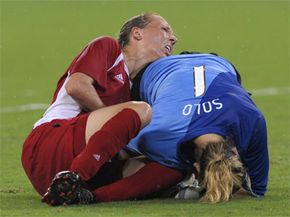Michael Phelps shared the spotlight at the Beijing Olympics with -- a swimsuit. The Speedo LZR racer swimsuit reportedly takes 20 minutes to put on, covers swimmers from chest to calf and, most important, smooths skin that normally "flaps" in the water. It gives swimmers a more frictionless glide. Oh, and it seems to help them smash world records.
The suit offers yet another example of athletes trying to winnow down a completion time when the body itself had reached its peak. Whether, like swim caps, we call these attempts "advances," or like steroids, we deride them as "doping," we can't avoid the bodily enhancements that turn up in sports.
Advertisement
What will we see next? Some officials say athletes will tamper with their very genes.
In gene doping, athletes would modify their genes to perform better in sports. We say would because no one has tried it yet, as far as we know, says Dr. Theodore Friedmann, head of the World Anti-Doping Agency's (WADA) gene doping panel. "It will happen," he says, "but we don't know when."
How would athletes do it? They might add genes to the ones they were born with, or they might tinker with how the body uses the genes they have.
Gene doping is an unintentional spin-off of gene therapy in which, doctors add or modify genes to prevent or treat illness. Gene doping would apply the same techniques to enhancing someone who is healthy. The line is fuzzy, but if the cells or body functions being modified are normal to start with, it's doping [source: Friedmann].
Two types of gene doping exist. In somatic cell modification, genes are modified in a bodily cell, like a lung or muscle cell. The changes aren't passed on to children. Today's gene therapy alters somatic cells. Germline modification, however, changes genes in a father's sperm, a mother's eggs or an embryo [sources: Hanna, Wells]. The genetic changes manifest in children and possibly in their children. So far, the U.S. government hasn't funded research on human germline modification, and other governments have banned it, so we'll talk about somatic cells [sources: Baruch, Hanna].
Read on to find out how future athletes might alter their genes.
Advertisement




